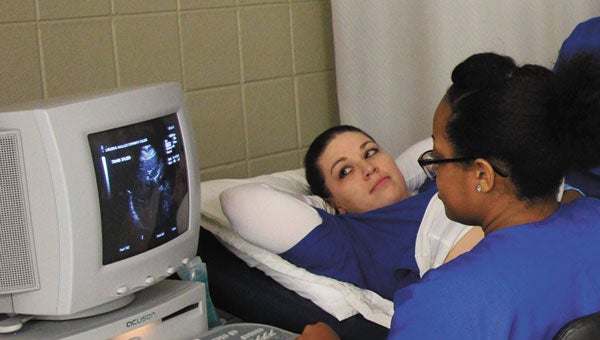Ultrasound jobs among state’s fastest growing
Published 12:00 am Thursday, February 19, 2015

Diagnostic Medical Sonography students practice. Shown are Terrin Nelson of Opp, seated; Brittany Cobb of Highland Home on the stretcher.
Diagnostic medical sonographers recently made the list of 40 high demand occupations that do not require a four-year degree and have competitive salaries.
DMS, which is among the career programs available at LBW Community College, is a procedure that uses high-frequency sound waves, or ultrasound, to produce dynamic visual images of organs, tissues, blood flow, or fetus inside the body, and is used to help physicians determine a medical diagnosis.
The state department of labor’s labor market information division recently compiled a list of these jobs, which ranges from commercial pilots to carpenters, with the majority having average annual salaries of more than $30,000.
The top five occupations statewide, which are ranked by anticipated growth are:
• engine and other machine assemblers, with an average annual salary of $35,687;
• occupational therapy assistants, with an average annual salary of $55,187;
• personal care aides, with an average annual salary of $17,830;
• diagnostic medical sonographers, with an average annual salary of $47,758; and
• physical therapist assistants, with an average annual salary of $53,714.
Locally, Lurleen B. Wallace Community College offers a diagnostic medical sonography degree program through its Associate in Applied Science program.
“LBWCC has an outstanding program in diagnostic medical sonography and prepares students for real-world application through hands-on learning,” said LBWCC President Dr. Herb Riedel. “Our program was first offered as a short certificate program in January of 2009, requiring 26 credit hours. In May 2011, the short certificate program was discontinued and replaced by the AAS degree program, which is a 76-credit hour program.”
Since its inception, 54 people have completed the program.
“A new DMS class is selected each year to begin the program in the fall term,” said Olive Bush, program director. “Students continue the program for four consecutive semesters and graduate with a degree at the end of the fall term the following year.”
Bush said they accept applications for the program through mid-June, but students must have completed all prerequisite courses by the end of that summer term.
Included in the 76 credit hours needed for the degree is the completion of nine prerequisite courses, or 27 credit hours, required before a student can begin the program.
“Our students receive training in the fields of acoustic principles and safety, abdominal, obstetrical, gynecologic and small parts sonography,” Bush said. “Graduates may have the opportunity to complete an additional semester upon graduation to receive a vascular certificate for the practice of vascular sonography.”
Statewide, the average per capita income for 2013 was $23,680, according to the U.S. Census Bureau.
Thirty-eight of the 40 occupations on the list have higher annual average salaries, and 32 of the 40 have annual salaries higher than $30,000.
The per capita income for Covington County was $20,391, according to the Census Bureau.
“It’s important that Alabamians who are entering the work force for the first time, or even those who are looking to rejoin it, know that there are many well-paying job out there that don’t require a formal education,” said Fitzgerald Washington, commissioner of the state department of labor. “Higher education is certainly important, and if that’s the direction your career choices lead you, that’s wonderful. If not, there are many other career paths out there in which workers can become just as successful.”




